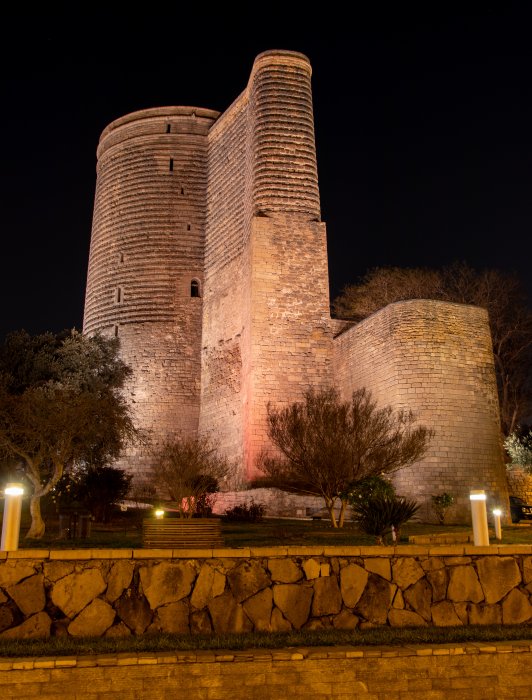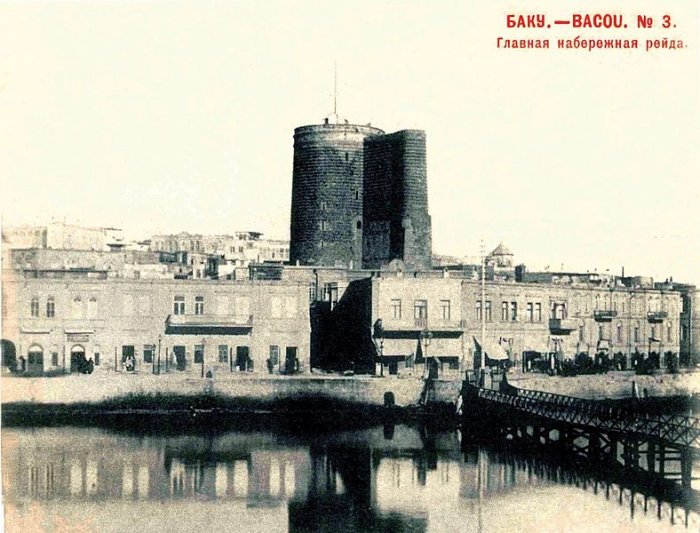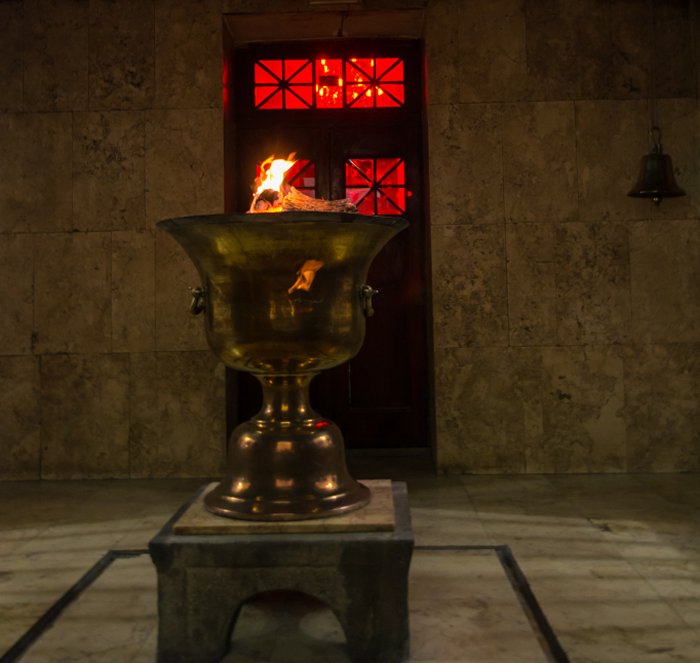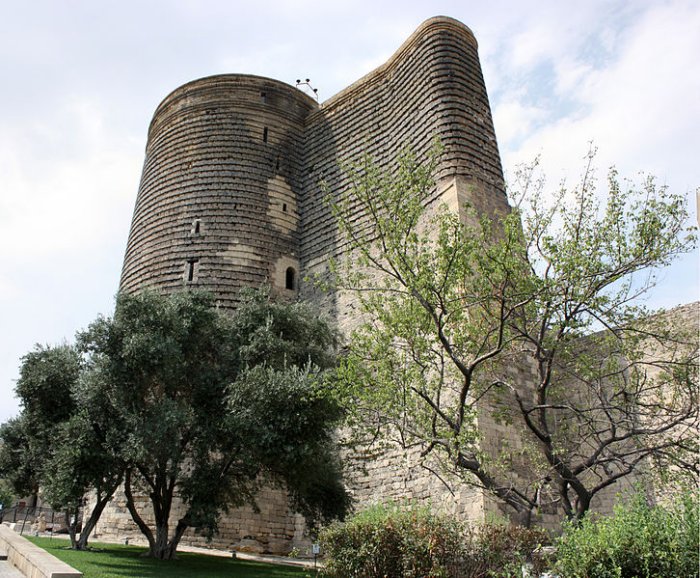Ellen Lloyd – AncientPages.com – Located in the heart of Baku, Azerbaijan, the Maiden Tower is the city’s most mysterious and impressive ancient structure. Being 29.5 meters (97 feet) tall and 17 meters (54 feet) in diameter at the base, the monument is impossible to miss, but why was it built and by whom?
Many theories are attempting to explain the purpose and history of the Maiden Tower, but conclusive answers to its existence and use are still missing.

Baku’s maiden Tower at night. Credit: Adobe Stock – Nurlan
The striking Maiden Tower has been a subject of many fascinating myths and legends, and who knows, may there is some truth to specific stories.
Being wholly built of stone and having no interior rooms, the Maiden Tower is today a symbol of Baku and a popular tourist attraction. The Tower houses a gift shop and a museum that gives visitors a good insight into the city’s history.
Who Were The Ancient Builders Of The Maiden Tower?
The age of the Maiden Tower remains uncertain, and the structure has been dated variously from the pre-Christian era to the twelfth century, and from the top of which, legend says, a distraught medieval maiden flung herself.” 1

An old postcard of Baku’s Maiden Tower. Credit: Public Domain
Some scholars say that the Tower was built in the 12th century, as an inscription on the side of the Tower dates it to this time period and names the architect as Masud ibn Davud. But other historians think that this plaque and inscription appeared later, to fix a hole in the brickwork.
Having studied the lime mortar and the color of the stones used to build Maiden Tower, some say that the Tower could have been built as early as the 8th century CE (as similar buildings were made in Gabala at the same time), but no later than the 10th century CE (since the stones used to build the Maiden Tower and a mosque from this time are nearly identical). Still, others say that, when you look at the construction, it’s clear that the bottom half is much older than the top half.
The bottom half was built in the 5th-6th centuries, and the top half was completed in the 12th century.” 2
There are also “archaeologists who believe the lower section of the tower is at least 2600 years old.” 3
Baku has been inhabited since the Bronze Age. However, the place started to develop with the emergence of the capital of the Shirvanshahs in 1385. Icheri Sheher, is the Old City of Baku where the Maiden Tower can be found. Being the oldest inhabited part of Baku, the area was often attacked, and “originally, there were two fortress walls to protect Baku, plus a wall between the sea and the city, though the outer wall has since been destroyed, and even the inner wall has fallen away in some.” 2
Could the Maiden Tower have been used as a military watchtower where guards monitored possible approaches of enemy forces? It is possible, but not everyone is convinced the Maiden Tower was a defense structure.
Legends Of The Maiden Tower And The Zoroastrian Connection
Professor Davud A. Akhundov emphasizes the importance of the seven fire exits on the top of the Tower. Zoroastrians believed that there are 7 Steps or 7 Sky to reach heaven, which is one of the reasons Akhundov argues the Maiden Tower was once Zoroastrians’ Fire temple.
“The researchers who believe the history of the Tower goes back to ancient times due to its architecture, consider it to be connected to the house of Zarathustra, the temple of fire-worshipers, and the goddesses Mitra and Anahita; that it belongs to the times of the fire-worshiping prophet (Zarathustra). According to the researchers, there is a probability that the Maidens’ Tower was a temple of fire-worshipers and was built on the shore of the Caspian Sea among natural eruptions of fire from beneath the earth’s crust.
The architecture was strongly influenced by the towers of the temples of Caspiana and Midia in VIII-VII centuries B.C. and was the very city of the god Bhagavanda.” 3
Those who are interested in myths and legends will find the Maiden Tower has many interesting stories to offer. Can perhaps some of the legends shed light on why, by whom, and for what reason the maiden Tower was constructed?
According to Nourida Ateshi-Gadirova, ᴀssociate professor of archaeological studies at the Khazar University in Baku, Azerbaijan, there is one particularly interesting legend that may be based on true events. It tells that “the city of Badikuba, which was defended by three walls, was under siege for 90 days by Shah Nureddin of Iran.

Was the Maiden Tower once a Zoroastrian temple? Credit: Antoine Taveneaux – CC BY-SA 4.0
On the shores of the Sea of Gulsum a dark temple within the city walls had smoke rising from it. Many ceremonies were being held there to protect the capital of the Land of Fires. At Yegirvand (in other versions, Mobedan), the chief priest, addressed the people after the ceremonies with the words
“The King will be killed tomorrow! An innocent force will destroy him!” Whereupon the doors of the temple opened, and the Daughter of Fire appeared amidst afire, with flames arising from her sword and hair. She left the temple and approached the chief priest. The priest asked her to save the sacred city of the god and the sacred temple of everlasting fire. The girl went to the residence of the Shah Nuraddin and fulfilled her duty by killing him.
Thus the Daughter of Fire fulfilled her sacred duty and saved her counterparts, but she had fallen in love with the enemy commander she had killed. She did not want to continue living after killing the one she loved, and drawing her sword she committed suicide in front of the temple. All the fires in the temple were extinguished and since that time, the temple has been called the Maidens’ Tower in her honour.”

The Maiden Tower in Baku. Credit: Frokor – CC BY-SA 3.0
According to the historian-architect D.A. Akhundov, this legend dates from much earlier times (VII-VI centuries B.C.) than the time the religion of Zarathustra became official (VI century B.C.). With the emergence of Zarathustra’s religion, the tribes of Amazons and the leading role of women in society began to collapse.” 3
The ancient mystery of Baku’s Maiden Tower remains unsolved. Was it once an astronomical observatory, a Zoroastrian temple, or a military structure? We cannot answer these questions. Nevertheless, the fascination with the enigmatic Maiden Tower lives on, and the beautiful monument of Baku is often featured in modern plays and poems.
Written by Ellen Lloyd – AncientPages.com Staff Writer
Copyright © AncientPages.com All rights reserved. This material may not be published, broadcast, rewritten or redistributed in whole or part without the express written permission of AncientPages.com
Expand for references
- Henry Albinson – Azerbaijan History, Early History
- Alex Bennett – Baku Travel Guide, Azerbaijan
- Nourida Ateshi-Gadirova – The Amazons Of The Caucasus: The Real History Behind The Myths





